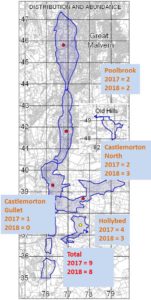This map shows the historical territories of skylarks on the Malverns shaded blue. There were 54 territories in 1988 including on the high hills (red dots). The 8 remaining territories recorded in June 2019 are the same as the 8 recorded in 2018 and compare with 9 in 2017. The number remains at a precarious level and a change in any of these remaining territories is very significant – for example the area nearest the gullet quarry has no skylarks this year or last after the one territory in 2017 was mown over in early July 2017 and has been more tightly grazed in 2018 and 2019. Click to expand the map. 2019 numbers have not been added – they were the same as 2018.
Update from the 2024 edition of the Birds and Butterflies of the Malvern Hills by Ian Wells In 1988 there were 54 pairs of skylarks recorded on the hills and surrounding commons. Numbers declined to the point where in 2016 no Skylarks bred on the high hills and numbers were much reduced on the commons. Six years later in 2022 Skylarks returned and at least one pair and probably 2-3 pairs bred on a small strip of longer un-grazed grass at the top of the Worcester Beacon and in the more lightly grazed area a little lower on the Eastern side of the Beacon. Less-tight grazing in some small areas seems to have made the difference, providing nesting cover and better food sources. It is difficult to be certain about breeding numbers because observers’ survey territories overlap leading to double-counting and Skylarks seen and heard might be prospecting and not settling to breed and also may include young.
Malvern Bird-group members met to discuss the topic and it seems that one-two pairs on North Hill, two, possibly three pairs on the Worcester Beacon, two or three pairs on Castlemorton common and up to four pairs on Hollybed common might be our best estimates of relatively stable breeding territories. This excludes birds on surrounding farmland.

